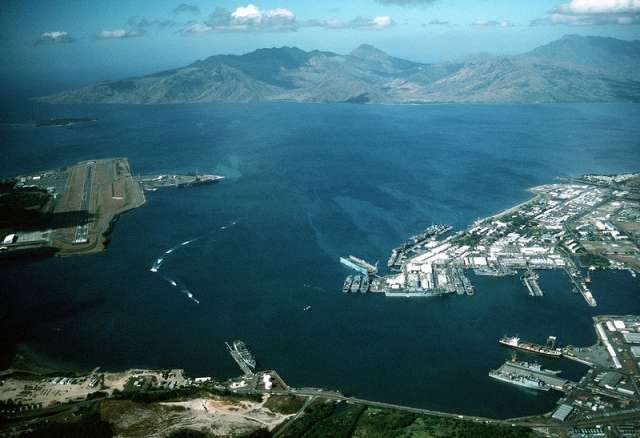Manila and Washington are said to be rushing to complete negotiations on the Agreement on Enhanced Defense Cooperation (AEDC) so both Presidents Aquino and Obama can seal the new security deal when the American head of state arrives next week.
If there is anyone in the government who can take credit—or blame—for the new security deal, it is Foreign Secretary Albert del Rosario, who now monopolizes the ear of the President when it comes to relations with China and the United States.
Our territorial conflicts with China are the reason for this new agreement, and the message del Rosario and Malacañang want to deliver is that the AEDC is the mechanism that will make the Chinese respect our rights to Scarborough Shoal, the nine islands and reefs we claim in the Spratly Islands, our continental shelf, and our 200 Mile Exclusive Economic Zone.
The truth of the matter, however, is that the deal negotiated by Secretary del Rosario will do no such thing.
No US obligation to defend Spratlys and Scarborough
According to Philippine officials, the new agreement is governed by the US-Philippine Mutual Defense Treaty (MDT) and that the MDT obliges the US to come to the Philippines’ defense in the event of an attack on Philippine territory, including our possessions in the West Philippine Sea or South China Sea. Here they cite Article V of the MDT, which says “an armed attack on either of the Parties is deemed to include an armed attack on the metropolitan territory of either of the Parties, or on the island territories under its jurisdiction in the Pacific or on its armed forces, public vessels or aircraft in the Pacific.”
The problem with this view is that that is not the way the US sees it. Indeed, the US has not deviated from the position explicitly stated several years ago by Morton Smith, a spokesperson of the U.S. Embassy; according to researcher Roland San Juan, Smith asserted that the Kalayaan islands are excluded from the scope of the treaty because the Philippines raised its claim to them over three decades after the MDT was signed in 1951.
Senkakus, yes; Spratlys, no
Washington’s distancing itself from the defense of the Kalayaan Islands is in contrast to US Secretary of Defense Chuck Hagel’s recent aggressive statements in Beijing over the disputed Senkaku Islands (Diaoyu Islands in Chinese) during his visit in early April. Hagel said, “I restated the principles that govern longstanding U.S. policy on the Senkaku Islands and other islands.
We affirmed that since [the Senkaku Islands] are under Japan’s administrative control, they fall under Article 5 of our Mutual Security Treaty.” Article V of the US-Japan Mutual Security Treaty provides that “an armed attack against either Party in the territories under the administration of Japan would be dangerous to its own peace and safety and declares that it would act to meet the common danger in accordance with its constitutional provisions and processes.”
The difference with the Philippines, in Washington’s view, is that, unlike Scarborough Shoal and the Spratly islands claimed by the Philippines, the Senkakus were under the administrative control of the prefecture of Okinawa when the US-Japan Mutual Security Treaty was signed and were thus covered by the restoration of Okinawa to Japan’s control in 1972.
Commenting on the contrasting US behavior on the two disputes, Rear Admiral Michael McDevitt, a retired US Navy officer who was director of the Pentagon’s East Asia Policy Office during the Bush II administration writes, “At first glance, the disputes China has with the Philippines over Scarborough Shoal in the SCS [South China Sea] appear similar to the ECS [East China Sea] with Japan because the US is a treaty ally of the Philippines.
Actually, however, the two situations are different. In the case of Scarborough Shoal, the Philippines did not have undisputed ‘administrative control’ prior to the 2012 confrontation over the islet. Second, the US is not directly involved in the Scarborough Shoal dispute because its mutual defense treaty with the Philippines does not obligate Washington to take sides over sovereignty questions.”
If the deal does not provide for US support for our territorial claims in the South China Sea, what benefits then do we get from it? Most likely an increase in military aid, including a few more antiquated Hamilton class cutters. If so, this is a very poor return for a larger US military presence, especially the Constitution-defying grant to operate US bases within Philippine bases, which the deal essentially is all about.
‘Pacific Pivot’ on the cheap
What is in it for the US?
The US has always said that its main interest in the South China Sea is “ensuring freedom of navigation.” The first thing to note here is that although China claims the South China Sea as a domestic waterway in its notorious Nine-Dash-Line claim, the threat of its interfering with freedom of navigation has always been remote. China is not about to court world condemnation by enforcing its domestic shipping regulations on a busy waterway through which an estimated one-third of international trade passes. Nor does it have the capability to do so, at least not for a long to come.
But even if the Chinese were to pose a threat to international navigation, the US does not need a Philippine outpost to accomplish its stated goal of protecting international shipping. Even with the US bases in the Philippines already gone in the mid-1990’s, the Pentagon had the South China Sea firmly under control: According to analyst William Berry, during the Mischief Reef crisis in 1995, then Assistant Secretary of Defense for International Security Affairs Joseph Nye “stated that if any conflict in the South China Sea threatens freedom of the seas, then the United States Seventh Fleet was prepared to provide escort services so that freedom of navigation could be protected.”
That this was no bluff was revealed in 1996, during the Taiwan Straits crisis, when two aircraft carrier battle groups were deployed swiftly and with ease out of Yokosuka, Japan, to show Washington’s support for Taiwan.
The fact is the US does not need bases in the Philippines for its upgraded military presence in the Asia Pacific. The loss of the Philippine bases in 1992 did not translate into any difficulties in the ability to deploy and logistically support its forces from the North Pacific to the Indian Ocean. The only significant modification to naval logistics that the event led to was the negotiation with Singapore for the provision of ship repair facilities. Indeed, the elimination of Subic and Clark was probably a big plus for the US since it did away with the great cost of maintaining large fixed bases.
So why does the US now want a higher military profile in the Philippines? This is owing to what one might call Washington’s “exhibitionist syndrome,” that is, the imperative it feels to “show the flag” to its allies and to China, and to do so in an inexpensive way, with no rent to the host country, with a quid pro quo involving just a few of what the Americans call “Excess Defense Articles” like antiquated cutters.
This is what John Feffer calls “Pacific Pivot” on the cheap in the era of Pentagon budget cutbacks, since using Philippine bases will involve probably just a fraction of having large fixed bases. As Frank Chang of the Foreign Policy Research Institute writes, “For the United States, the…agreement helps demonstrate to the Philippines and the region its commitment to the Obama administration’s oft-mentioned pivot or rebalance to Asia and to do so without the expense of building or maintaining new military installations.” He adds, “It clearly offers the United States a cost-effective way to enhance its presence in Asia, something that Washington has wanted to do for a long time.”
Strategic costs for the Philippines
But coming back to what the Philippines gains from the coming agreement, the increase in obsolete military donations from Washington will be more than offset by the negative strategic consequences. Three of these must be highlighted. First of all, the coming agreement will, paradoxically, bring us farther away from a resolution to the territorial disputes with China because this issue will be marginalized by the dynamics of a superpower conflict, to one side of which the Philippines will be considered an adjunct.
Second, it will definitely turn the Philippines into another of Washington’s front line states, like Afghanistan and Pakistan, with all the detrimental and destabilizing effects of such a status, including the subordination of the country’s economic, social, and cultural dynamics to Washington’s security needs. Third, it will move the region farther away from the negotiation of a collective security agreement that is a far better alternative to the current state of volatile balance of power politics, where a simple thing like a ship collision involving antagonistic parties can lead to a bigger conflict.
From balance of power to collective security
Make no mistake: the territorial conflict with China is real, but the way to resolve it is to rely on international law and diplomacy, and this is a terrain in which the Philippines has a big advantage. As I said in an earlier column, the submission of the 1000-page “memorial” delineating our entitlements in the West Philippine Sea to the United Nations Arbitral Tribunal is a giant step in this direction. Beijing knows it does not have a leg to stand on in international law, which is why they have been pushing us to drop the case on pain of “damaging bilateral relations.”
We must also maximize the diplomatic option, where we too have an advantage over Beijing. We must also press our ASEAN partners to remind Beijing to live up to the commitment to negotiate a binding code of conduct on maritime behavior in the West Philippine Sea that it made at the foreign ministers’ meeting in Brunei in June 2013. It was pressure from ASEAN and internationally that forced Beijing to make this commitment, and it will be consistent pressure that will force it to follow through on it.
Still on the diplomatic track, we should prepare the ground at the United Nations General Assembly for the eventual introduction of a resolution condemning Beijing’s unilateral annexation of over 80 per cent of the South China Sea, brusquely disregarding other littoral states’ rights to their continental shelves and 200-mile Exclusive Economic Zones. There’s a very good recent precedent: Beijing’s aggressive annexationism based on its arbitrary Nine-Dash-Line claim is essentially similar to Russia’s gobbling up of Crimea, which the General Assembly condemned few weeks ago.
The strategic aim of our diplomatic efforts must be to bring about a collective security agreement for the region that would include ASEAN, Japan, the two Koreas, and China. The ASEAN Regional Forum was headed in this direction in the 1990’s, despite the opposition of the United States, which arrogated unto itself the role of serving as the enforcer of stability in the region. Its momentum was, unfortunately derailed by the Asian financial crisis in 1997, which swept the rug from under the credibility of ASEAN’s major states. Though the process will be difficult, it is time to revive this project of collective security since the unstable and volatile balance of power politics favored by Washington is not a viable mechanism for regional peace and security.
With the impending basing agreement with the US, we are right back to our position during the Cold War, when we played the role of handmaiden to the US strategy of Containment by hosting two huge military bases. The small window of opportunity to forge an independent foreign policy that we gained with the expulsion of the US bases in 1992 will disappear with the impending signing of the Agreement on Enhanced Defense Cooperation with the US.
As many have noted, President Aquino’s presidency already has two important legacies: the anti-corruption campaign and the peace agreement with the Moro Islamic Liberation Front (MILF). Unfortunately, these achievements will be cancelled out by his embrace of Secretary Albert del Rosario’s one-dimensional diplomacy of reintroducing a massive American military presence in the Philippines.
Published in INQUIRER.net on April 23, 2014. Walden Bello represents Akbayan (Citizens’ Action Party) in the House of Representatives.










